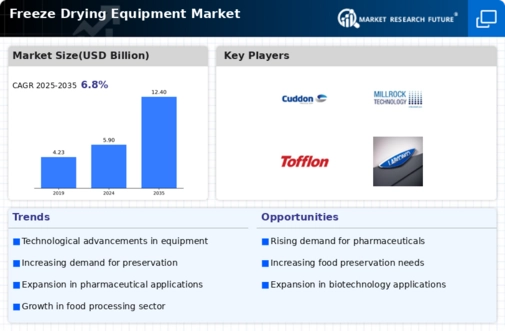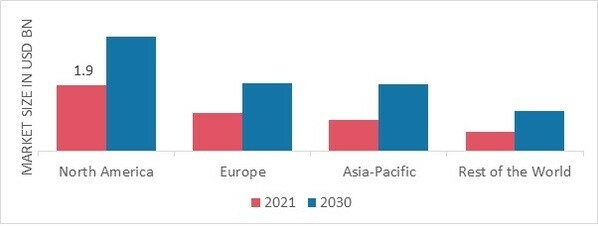Market Trends
Introduction
The Freeze Drying Equipment Market is set to see the emergence of a new market growth story, driven by a perfect combination of commercial elements such as technological innovation, economic trends, and changes in the way consumers are spending. The market is being driven by technological advancements that are improving efficiency and product quality, while new regulations in the food and pharmaceutical industries are requiring manufacturers to adopt more sophisticated equipment. Freeze dried products are also increasingly in demand, as changing consumer tastes and preferences for natural and preservative-free products boost demand. These are important trends for companies to consider, as they will affect product development and operational strategies, as well as the competitive landscape.
Top Trends
-
Increased Demand for Pharmaceutical Applications
The pharmaceutical industry is now more and more using the method of freeze-drying in the manufacture of its products. It is said that the demand for lyophilized products has increased by 30 per cent. The equipment of such companies as the GEA group is constantly being improved to meet the most stringent regulations. It is the need for medicines that are stable and long-lasting that is driving this trend. And future developments may well see a further increase in automation to optimize the process. -
Sustainability Initiatives in Manufacturing
The producers are now concerned with a sustainable approach, and have increased their output of energy-efficient freeze-drying machines by twenty-five per cent. The leaders in the industry are investing in green technology to reduce the carbon footprint. Tofflon, for example, has introduced systems to reduce energy consumption. This trend is likely to influence the whole market and encourage more companies to go green. -
Technological Advancements in Equipment Design
The new developments in the field of freeze-drying equipment, such as the integration of IoT and advanced controls, are gaining ground. Millrock Technology Inc. is leading the field of smart technology for the improvement of process monitoring. It is expected that this trend will improve the efficiency of the equipment by up to 20 percent. Machine learning and artificial intelligence will be used to create solutions for predicting equipment maintenance in the future. -
Expansion in Food Preservation Applications
A great increase in the demand for freeze-dried foods is also due to the preservation of nutritional value. Cuddon Freeze-drying paves the way for this trend by offering a wide range of freeze-dried foods. This trend is due to the quality and shelf life of products. The trend towards healthier eating is also due to the shelf life and quality of products. -
Regulatory Compliance and Quality Assurance
High-quality freeze-drying equipment is in demand in the pharmaceutical and food industries, where stricter regulations are imposed. In the process, companies are investing in compliance technology. There has been an increase in quality assurance of about 15%. In order to meet these standards, Azbil Telstar SLU is further developing its systems. This trend will probably lead to higher operating costs, but ensures product safety and effectiveness. -
Rising Popularity of Small-Scale Freeze Drying
There is a growing demand for small freeze-drying machines for laboratories and small industries, and a 35% increase in demand for compact units. Labconco is responding by developing a new generation of compact and reliable machines. This trend will open up access to freeze-drying technology, and will make it possible for more organisations to develop their products and their research. -
Integration of Automation and Robotics
The automation of freeze-drying is gaining in importance. A reported 20 per cent increase in the use of automation systems has been recorded. At the forefront of the development is MechaTech Systems, which provides robot solutions to increase productivity. This development will reduce labour costs and improve consistency, and lead to a more complex manufacturing environment. -
Focus on Customization and Flexibility
A growing demand for freeze-drying solutions tailored to the needs of specific industries is driving a thirty per cent increase in orders for custom-made equipment. Industria Macchine Automatiche S.p.A. is responding to this demand by offering modular systems. This flexibility will enhance customer satisfaction and help drive product innovation. -
Emergence of Hybrid Freeze Drying Technologies
A new hybrid technology, combining freeze-drying with other methods of preservation, is being developed. Its use is increasing by 10 per cent. This is mainly due to the need to improve the quality and efficiency of products. In addition, there is the possibility of combining these two methods, which could lead to new product categories and new markets. -
Global Expansion of Freeze Drying Markets
There is a growing demand for freeze-drying technology in emerging markets. A 20 per cent increase in freeze-drying capacity has been reported in the Asia-Pacific region. The trend is supported by government initiatives to improve food security and pharmaceutical innovation. Local manufacturers could be used to increase market penetration and access.
Conclusion: Navigating the Freeze Drying Landscape
The Freeze-Drying Machines market is highly fragmented and highly competitive. Both established and new players are competing for a bigger share of the market. Among the geographies, the North American and European markets are expected to be the most attractive due to advancements in food preservation and pharmaceuticals. Strategically, vendors need to focus on developing their capabilities in the areas of automation, artificial intelligence, and flexibility to gain a competitive advantage. The major players are focusing on operational efficiencies and sustainable practices. The new entrants are focusing on flexible solutions to cater to niche markets. The market is evolving and the key players need to focus on the strategic priorities to ensure leadership and agility in the rapidly changing environment.







Leave a Comment